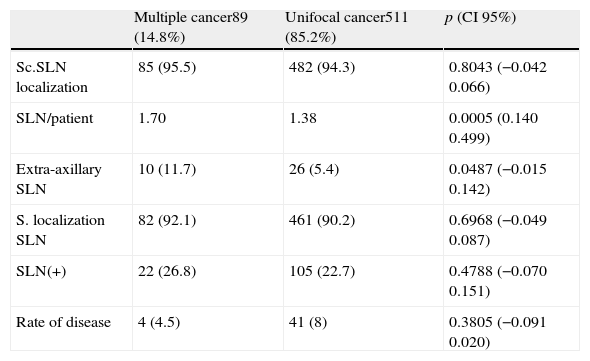Sentinel lymph node biopsy (SLNB) as a staging procedure in multiple breast cancer is a controversial issue. We have aimed to evaluate the efficacy of sentinel node (SN) detection in patients with multifocal or multicentric breast cancer as well as the safety of its clinical application after a long follow-up.
Material and methodsA prospective descriptive study was performed. Eighty-nine patients diagnosed of multiple breast cancer (73 multifocal; 16 multicentric) underwent SLNB. These patients were compared to those with unifocal neoplasia. Periareolar radiocolloid administration was performed in most of the patients. Evaluation was made at an average of 67.2 months of follow-up (32–126 months).
ResultsScintigraphic and surgical SN localization in patients with multiple breast cancer were 95.5% and 92.1%, respectively. A higher percentage of extra-axillary nodes were observed than in the unifocal group (11.7% vs. 5.4%) as well as a significantly higher number of SN per patient (1.70 vs. 1.38). The rate of SN localization in multicentric cancer was slightly lower than in multifocal cancer (87.5% vs. 93.1%), and the finding of extra-axillary drainages was higher (20% vs. 10%). Number of SN per patient was significantly higher in multicentric breast cancer (2.33 vs. 1.57). No axillary relapses have been demonstrated in the follow-up in multiple breast cancer patients group.
ConclusionsSLNB performed by periareolar injection is a reliable and accurate staging procedure of patients with multiple breast cancer, including those with multicentric processes.
La biopsia selectiva del ganglio centinela (BSGC) como procedimiento de estadificación en el cáncer de mama múltiple es cuestión de controversia. Nuestro objetivo es evaluar la eficiencia de detección del ganglio centinela (GC) en las pacientes con cáncer multifocal o multicéntrico, y la seguridad de su aplicación clínica, tras un seguimiento prolongado.
Material y métodosSe realiza un estudio prospectivo descriptivo. Se estudian 89 pacientes con cáncer múltiple de mama sometidas a BSGC (73 procesos multifocales, 16 multicéntricos), comparándolas con las que presentaron neoplasia unifocal. En la mayor parte de las BSGC se realizó administración periareolar del radiocoloide. Se realiza la evaluación a los 67.2 meses de seguimiento medio (32-126 meses).
ResultadosLas tasas de localización gammagráfica y quirúrgica del GC en las pacientes con cáncer de mama múltiple fueron respectivamente 95.5% y 92.1%, observándose mayor porcentaje de GC extraaxilares que en los procesos unifocales (11.7% frente a 5.4%) y un número de GC por paciente significativamente mayor (1.70 frente a 1.38). La tasa de localización del GC en el cáncer multicéntrico fue ligeramente inferior al multifocal (87.5% frente a 93.1%) y el hallazgo de drenajes extra-axilares más elevado (20% frente a 10%). El número promedio de GC por paciente fue significativamente superior en el cáncer multicéntrico (2.33 frente a 1.57). No se han registrado recurrencias axilares en el seguimiento de las pacientes con cáncer múltiple.
ConclusionesLa BSGC mediante inyección periareolar es un procedimiento preciso y fiable de estadificación del cáncer de mama múltiple, incluso multicéntrico.
Article

Revista Española de Medicina Nuclear e Imagen Molecular (English Edition)









